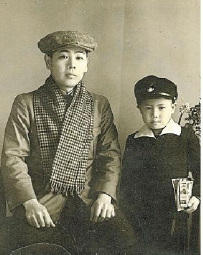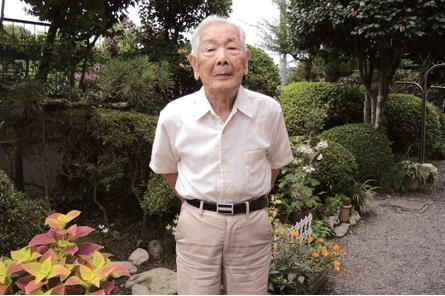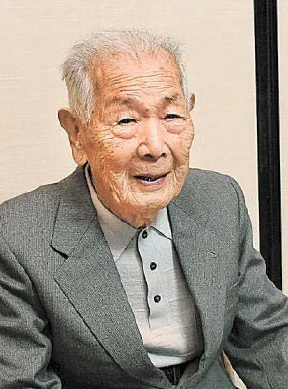BIOGRAPHY
Takejirō Takayama was born in Tamakawa Village, Abe District (now part of Shizuoka City), Japan, on 30 September 1909, the second of three children – two sons and one daughter. In 1934, when he was around 25, he worked as a carpenter, assisting in the construction of the Shizuoka City municipal office. At the age of 26, Takayama relocated to Okitsu, Shimizu Ward, Shizuoka City, with the assistance of his relatives. At the age of 27, he got married, and subsequently had six children. As of 2019, his family consisted of over fifty people spanning five generations.
After the outbreak of World War II, he managed to avoid military conscription following a medical check-up. However, he was compelled to work for two years in a munitions plant in Shimizu Ward as part of Japan’s mobilization effort. During his time there, he produced salt by sprinkling seawater in the yard, letting it dry in the sun, loading it into a roughly 23kg sack, and transporting it to Tochigi Prefecture by train. He then exchanged the salt for rice. Using his bartering skills, he managed to overcome the food shortages caused by the chaos and upheaval of the war. On one occasion, he climbed onto a roof and observed an Allied bombing raid.
Takayama chose to pursue work in Tokyo after coming across a job advertisement on a recruitment postcard, despite facing opposition from those around him. Upon arrival, he sought directions to the company at a police box but reconsidered when a policeman advised him, “You shouldn’t work for this kind of company.” In one instance in Ueno, he felt compelled to purchase breath mints from an assertive street peddler, recalling, “He spoke to me with such force that I can still hear it like it was yesterday.” Eventually, he abandoned his job search in Tokyo. After the war, he found employment at a wood factory owned by a paper company and continued to work there until his retirement. During this period, he worked diligently to provide for his six children.
His wife passed away around 1997, at the age of 88. His daughter-in-law, who lived with him, described him as easy to cook for, indicating that he wasn’t particular about what he ate: “I don’t prepare anything special. He eats what the rest of the family does.”
According to doctors, when he was 106, aside from some blood pressure issues and being hard of hearing, he was in good health. Statements like “I don’t care about medicine, but I take it every day because the doctors want me to” reflected his easygoing, care-free attitude toward life. Takayama took pleasure in gardening, mentioning at the age of 106, “I stopped pruning the pine trees from high up using scaffolding, but I still tend to my rhododendrons.” He cultivated cucumbers, peas, and cabbages on a neighbor’s vegetable plot. His other hobbies included reading the newspaper, which he read from start to finish every single day, and watching TV; he particularly enjoyed watching Mito Kōmon, a historical drama set in the Edo Period. Although hard of hearing at this time, he claimed to more or less understand the plot by relying on lip-reading and subtitles.
In 2019, at the age of 109, Takayama lived with his eldest son Haruo, Haruo’s wife, and his grandchild. He described his family as his greatest asset. Takayama strongly advocated for peace due to his experiences during World War II, which he described as the darkest time of his life. He dreamed of a world where countries helped one another instead of fighting. Even at the age of 108, he read the newspaper every day, paying particular attention to situations in North Korea and the Middle East. Reflecting on the end of the Heisei Period (1989–2019), which lasted 30 years, he said, “it went by in the blink of an eye.” Regarding the beginning of the Reiwa Period with the ascension of Emperor Naruhito in May 2019, he expressed, “I want him to become a symbol of Japan and peace. I hope Reiwa is an age without war where countries get along with one another. That’s all I want.”
RECOGNITION
In 2017, Takayama was visited at his home by city officials, including the mayor, and given congratulatory gifts to celebrate his 108th birthday. He was the oldest man in Shizuoka City at that time.
On 6 December 2018, following the death of 109-year-old Yoshitaka Ohira of Fujinomiya, he became the oldest living man in Shizuoka Prefecture, at the age of 109.
On 8 May 2019, at the age of 109 years, 220 days, he surpassed the final age of Tarō Ōta (1905–2015) of Hamamatsu City, becoming the oldest man to ever live in Shizuoka Prefecture. In September of the same year, he celebrated his 110th birthday, becoming the first male supercentenarian in the Prefecture.
In September 2019, he was reported as the sixth-oldest living person in the Prefecture, and the second-oldest living person in Shizuoka City, behind Mika Sugiyama.
ATTRIBUTION
* “健康長寿県 静岡の – 百寿者に聞いた” – Shizuoka Health and Longevity Foundation
* “茶寿 高山さんにお祝い品を贈呈 静岡市” – Shizuoka Shimbun, 8 October 2017
* “明治から4時代…「平成あっという間」 108歳高山さん” – Shizuoka Shimbun, 2 December 2017
* “明治生まれ 願う 平和 高山竹治郎さん109歳” – Shizuoka Shimbun, 30 April 2019
* “110歳高山さん死去 県内最高齢の男性” – Chunichi Shimbun, 21 January 2020




